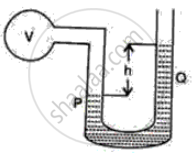Advertisements
Advertisements
Question
State and explain Pascal's law of transmission of pressure.
Solution
Pascal's law states that pressure applied to an enclosed liquid, is transmitted equally to every part of the liquid.
Means when pressure is applied at a point in a confined fluid, it is transmitted undiminished and equally in all directions throughout the liquid.
APPEARS IN
RELATED QUESTIONS
Consider the equations `P=lim_(triangles->0)"F"/(triangle"S")` and P1 - P2 = pgz. In an elevator accelerating upward
State Pascal's law of transmission of pressure.
The atmospheric pressure at a place is 650 mm of Hg. Calculate this pressure in Pascals (Pa).
How does the liquid pressure on a diver change according to the following condition:
When the driver moves horizontally
How does the liquid pressure on a diver change according to the following condition:
When the driver moves to the greater depth?
The following figure shows a manometer containing a liquid of density p. The limb P of the manometer is connected to a vessel V and the limb Q is open to atmosphere. The difference in the levels of liquid in the two limbs of the manometer is h as shown in the diagram. The atmospheric pressure is P0.
(i) What is the pressure on the liquid surface in the limb Q?
(ii) What is the pressure on the liquid surface in the limb P?

Unit of pressure is
Assertion: Pascal’s law is the working principle of a hydraulic lift.
Reason: Pressure is thrust per unit area.
